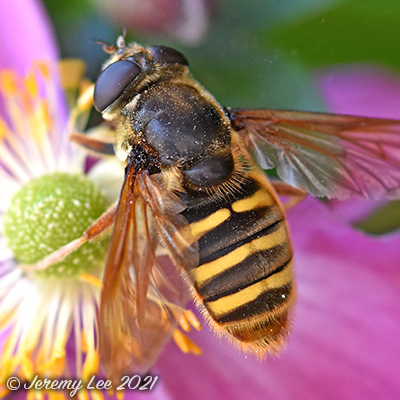
 |
|
Scientific Classifications explained » Amphibians » Ants » Aphids » Bees » Beetles » Birds » Bugs » Butterflies » Caterpillars » Damselflies » Dragonflies » Earwigs » Flies » Frog/Leafhoppers » Fungi » Galls » Grasshoppers » Harvestmen » Hoverflies » Lacewings » Ladybirds » Leaf Mines » Lichens » Mammals » Millipedes » Mosses » Moths » Sawflies » Slugs » Snails » Spiders » Trees & Shrubs » Wasps » Wild Flowers » Woodlice » Postboxes |
UK Nature > Hoverflies > Sericomyia silentis

Scientific Name: Sericomyia silentis Common Name: Bog Hoverfly Sericomyia silentis, more commonly known as the Bog Hoverfly or the Yellow-barred Peat Hoverfly, is a large and conspicuous hoverfly typically found in boggy habitats, especially in the north and west of Britain; it seems to be very mobile though, and in some years will turn up in woodland rides and meadows far from obvious breeding sites, even in counties such as Warwickshire where peatlands are few. Comparison is only really required with S. lappona, which averages smaller, has whitish abdominal markings, a reddish scutellum (but beware the occasional silentis with a reddish scutellum) and orange legs. Adults fly from May to November, peaking in July, a little later than S. lappona. They visit flowers such as brambles, thistles, knapweeds and Devil's-bit Scabious andy can make a high-pitched buzz when resting. The rat-tailed larvae develop in peaty pools and ditches. |
|

https://www.uknature.co.uk is a website dedicated to showing the immense diversity of UK nature and wildlife. Our vast range of habitats, from lowland arable to snow covered mountains, from storm-ravaged coastlines to peaceful inland freshwater lakes and rivers, from dry, sandy heaths to deciduous and coniferous forests, all these habitats contribute to the abundance of UK nature. We have wild birds in huge numbers either residing or visiting our shores (597 recorded species as at July 2013) and we must also not forget the humble back garden with its grass lawns, flower beds filled with nectar rich flowers, shrubs and trees, all designed to attract huge numbers of insects such as bees, moths, butterflies and hoverflies; and finally the small ponds which provide safe havens for frogs, toads, newts and even slow worms and grass snakes. www.uknature.co.uk is the showcase for my personal passion, photographing uknature in all its glory. I sincerely hope you all enjoy the fruits of my labours. This site and all images contained therein is © Jeremy Lee 2004 - 2025. All Rights Reserved. Site design by Jeremy Lee. Site development & IT Support by Stuart Lee. |